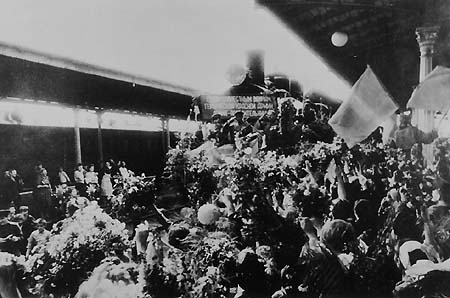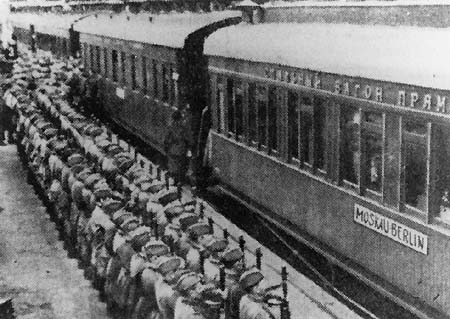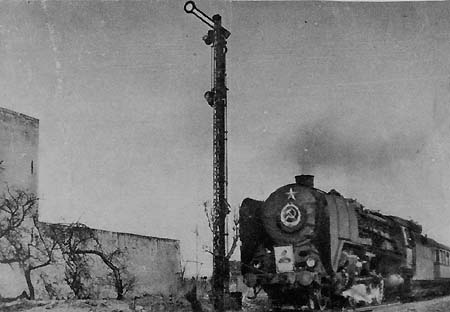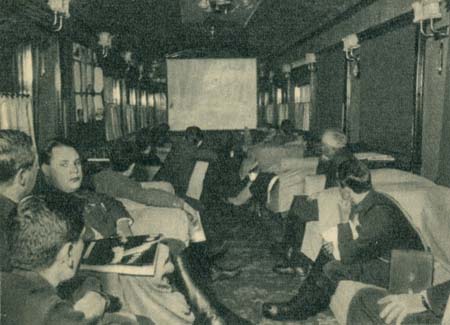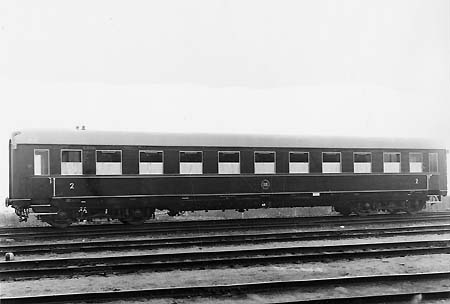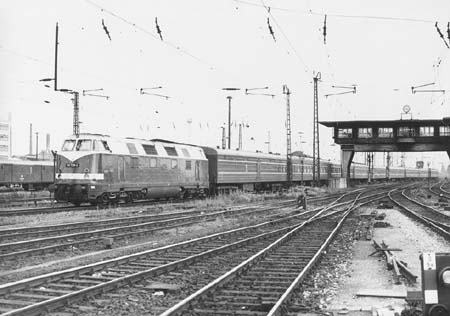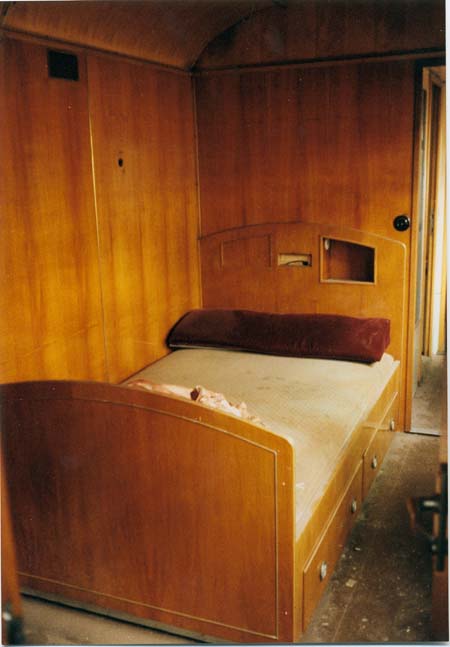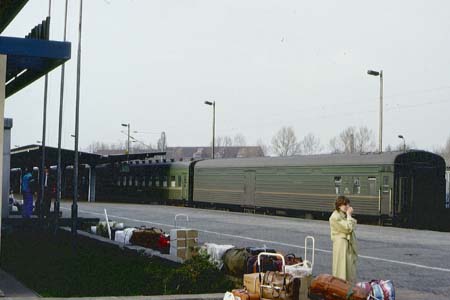
| trains-worldexpresses.com |

| |||||||
| TRAINS | World-Trains | Orient-Ex | Mideast | Indian Mail | Transsiberian | Rome-Ex | Cape to Cairo | Sud-Ex | ...adieu... |
|
The Myth |
Chronology |
Nord-Express |
Siberien-Express |
Nordroute |
Kurier 1 |
Transmanchourien |
Shanghai-Express |
Allied Forces |
Blauer Express | Moskva-Express | Eastern Europe | Baltics and Finland | Red Arrow | Moscow - Beijing | Tourist Specials | China | Far East | Japan | Travels - Reisen | Sibérie adieu | |||||||||
|
"B l a u e r E x p r e s s"
The victorious Red Army operated its first military freight train from Kuestrin to Berlin Lichtenberg Station on April 25, 1945. It ran on standard gauge, according to historian Laurenz Demps. The main line from Poland had one track converted to broad gauge and on May 5 or 7 came the first broad gauge military train to Berlin. The sensation was the arrival of the first direct express from Moscow at Berlin Schlesischer Bahnhof with a Russian Eu class 0-10-0 steam locomotive and even wooden ex-CIWL cars, which had been requisitioned in 1918. This first train left Moscow on June 25, 1945. The “Taegliche Rundschau” enthusiastically described the luxury of this express, its sleepers, restaurant, bathroom and its cinema car. But an even more prominent train was to arrive at Berlin on July 17 - the special which brought Stalin and Molotov to the Potsdam conference. German publications mentioned a Northern route, but Stalin’s minister Beriya had confirmed a route length of 594 km through Poland, that meant the direct way was taken. The few photographs are showing DA 20-27, a USA/TC diesel type, and the E1387 steam locomotive at Potsdam, which hauled the blue and green cars. Alexander Tchaikovsky gave a description, camouflaged as a novel: Traction was by the American diesel, whilst the blue Russian 0-10-0 seemed to have been used only additionally. At Dnepropetrovsk later the S0 17-1613 (a 2-10-0) was on exhibition, described as the locomotive which hauled Stalin’s train as far as Berlin. But another report said, that the only broad gauge engines at Berlin were from the E group and a re-gauged German 52. In September 1945 the tracks from the new Russian border station Brest-Litovsk to Berlin were rebuilt to standard gauge. According to Demps, on October 3 started the daily express 2/1 from Berlin to Brest, where the passengers had to change to broad gauge. A picture showed the war-type engine 42 845 at Schlesischer Bahnhof, but it is not known if it was train 1. Later, Wolfang Theurich of Waggonbau Goerlitz discovered a list of the cars for the Soviet administration SMAD, including sleepers and coaches, diners however only “in reserve”. A railway official (who didn’t mention his name) confirmed 6 train sets with ex-Belgian, Dutch, French and Italian coaches, from 1946 being painted light-blue and then it became known as “Blauer Express”. Its Mitropa sleeper however was red. Even requisitioned red ex-CIWL cars were in service. Temporarily there was a branch from Potsdam Wildpark, united with train 2 from Schlesischer Bahnhof at Berlin Koepenick. In 1950 old DR coaches were rebuilt to WLC (4-berth) sleepers and in 1951 8 sleepers 1st class (WLA) and 27 ones with 4-berth compartments (WLC), now green, were built for train Dm 2/1. The “Funk-Illustrierte” of May 13, 1951 wrote: “The Blauer Express is the first de-Luxe, which now runs from Berlin via Brest-Litovsk to Moscow”. Though that’s wrong, it could mean that from now it had the new cars, according to G. Stetza including a Mitropa diner. Or the modest civilian D4/3 was meant, which at Poznan changed cars with the Balt-Orient-Express. In 1950 it had got a coach Paris - Warsaw from the Nord-Express, which had changed its route to Stockholm, and in 1951 it was announced for Berlin - Brest services. The most interesting feature of the "Blauer Express" always had been its traction. SMAD provided its own service by the "Kolonnenlok", first with series 42 (2-10-0), then 03 (4-6-2) and then 01 (4-6-2), from 1947 rebuilt and painted blue with red wheels. And they did run through Poland as far as Brest, with 3 to 4 changes of engine! For the secrets of engines rebuilt for burning coal dust see the chapter The Myth. Nearly nothing would have been known about the connecting Russian train Brest - Moscow, if not the U.S. Admiral Leslie C. Stevens would have written his report "Russian Assignment". In July 1947 he traveled from Berlin on the "international car" (the red sleeper), reserved for high officers, and he took food and water supplies with him, for there was no restaurant service. At Brest-Litovsk he had to change to the Russian train. "We went to bed in a sleeping-car which was as comfortable as a sleeper can be - made in Germany … There was water and even a dining-car." What locomotives might have hauled this train in Russia? The Soviets had requisitioned German 03 Pacifics (then TS) and also streamlined 0310 Pacifics. Engineer and historian J.B. Kronawitter had found out that the TS was in service at Minsk. But if it hauled the Berlin train may for ever remain a secret. Soviet military express Moscow - Brest - Berlin, first arrival at Berlin June 28, 1945 on broad gauge, locomotive and cars Russian, estimated formation: EU 713 Some "hard" 20.2 m and 18 m types 3 unknown ones, possibly 20 m and cinema 1 "soft" class with 4-berth compartments 1 spalnyi vagon ex-CIWL sleeper series 1839 -…… from 1909 1 Restoran ex-CIWL (from CGC 1899?) ? possibly an ex-CIWL van with bath D2/1 "Bauer Express" Berlin - Brest on standard gauge; consist ca. 1947 - 50: 1 car for locomotive staff 2 vans 12 coaches and 1 sleeper, by SMAD 1 heating generator van (in winter) Traction 1947 - 54: German 01 class as far as Brest, change of locomotives at Frankfurt (0), Poznan, Warszawa, during winter also at Kutno. Requisitioned German, Belgian, Dutch, French and Italian coaches, light blue, sleeper Mitropa-red. In 1950 sleeping cars were rebuilt from coaches, also foreign ones, and in 1951 new sleepers were built, now DR-green. SMAD sleeping and dining cars (according to Wolfgang Theurich):
Coaches numbered from 3514 upward. Also known are nos. 5005 ex WL 223591, 5006 ex WL 1211, 5007 ex WL 222670 and 5182 ex WR 768. DR sleeping-cars:
Brest - Moscow In 1947 (according to Leslie G. Stevens, no formation): 1 Spalnyi vagon (sleeper, ex-Mitropa, red), 1 diner and other cars, by SZD. 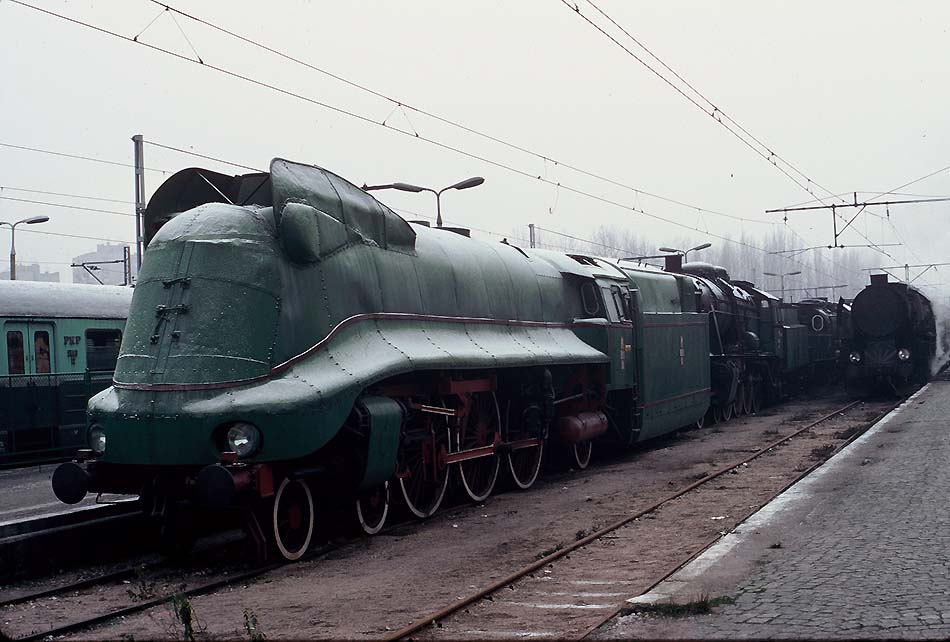 Pacific Pm3 of PKP, ex-German 0310, in the background Os24 and Ty2, on exhibition at Warsaw Glowna, Nov. 1989 (WS)
Download this picture with 1500 x 1000 pix, 300 dpi (479 KB)
|
